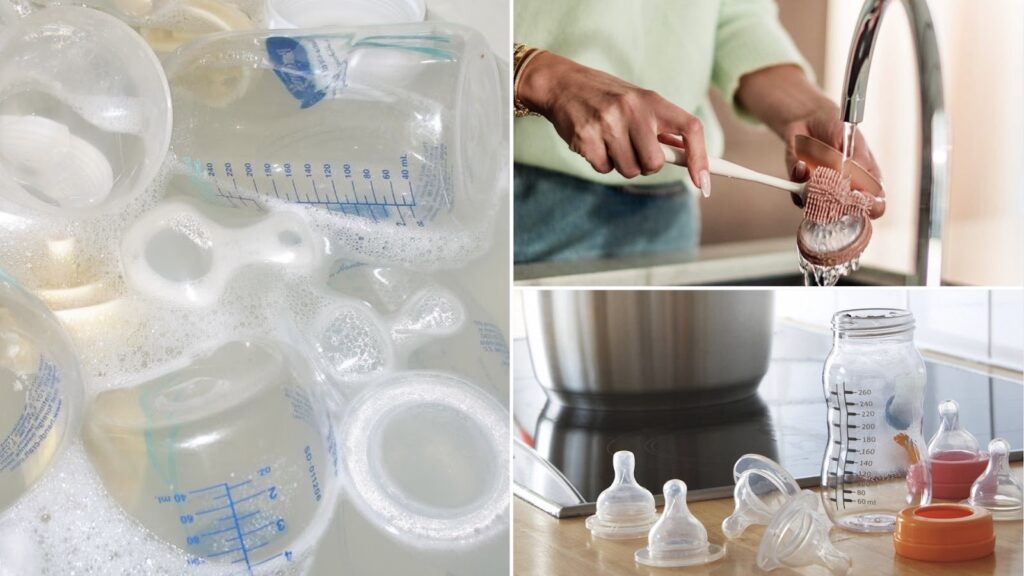Washing baby bottles may seem like a simple task, but ensuring they are properly cleaned is where it becomes tricky. Knowing how to wash baby bottles the right way will help prevent bacteria buildup and keep your baby’s feeding routine safe.
Source: Pinterest
In this guide, we’ll walk you through 10 easy steps to ensure every bottle is spotless and ready for use. Let’s get right into it.
1. Disassemble the Baby Bottle Properly
Before you begin washing, disassemble each part of the baby bottle. Separate the nipple, cap, and bottle to ensure every piece gets thoroughly cleaned.
Source: Pinterest
This will prevent any milk residue from staying trapped in the bottle or nipple, which can lead to bacterial growth. It’s an essential part of understanding how to wash baby bottles effectively.
2. Rinse the Bottle Immediately After Feeding
As soon as your baby is done feeding, rinse the bottle in warm water. This step helps remove milk remnants and reduces the buildup of milk residue inside the bottle.
Source: Pinterest
By doing this right after feeding, you’ll make the full cleaning process much easier later on. It saves time too.
3. Use a Baby Bottle Cleaner for a Deeper Clean
To give the bottles a more thorough clean, use a specialized baby bottle cleaner. These cleaners are specifically designed to be gentle on baby bottles while removing stubborn milk stains.
Source: Pinterest
Choose a cleaner that’s free of harsh chemicals, making it safe for both your baby and the environment. You will find most of these gentle cleaners in supermarkets.
4. Prepare a Basin with Warm, Soapy Water
Fill a clean basin with warm water and a gentle dishwashing soap. Place all parts of the disassembled bottles into the basin.
Source: Pinterest
Let them soak for a few minutes to loosen any leftover milk particles and make scrubbing easier. This is where washing infant feeding bottles becomes straightforward and hassle-free.
5. Scrub the Bottle and Nipple with a Brush
Use a bottle brush to scrub the inside of the bottle, paying close attention to the bottom where milk tends to collect. For the nipple, use a smaller nipple brush or the tip of the bottle brush to clean inside.
Source: Pinterest
Ensure you clean around the edges and inside the nipple holes to remove any trapped milk. This might take a while, but it’s worth it.
6. Pay Attention to the Bottle Cap and Rings
When washing your baby’s feeding bottles, don’t forget the bottle caps and rings. These smaller parts can easily collect milk residue in their grooves, so make sure to give them a good scrub.
Source: Pinterest
You can also use a toothbrush or nipple brush to get into tight spaces. This step is so important. Don’t skip it.
7. Rinse Everything Thoroughly
Once you’ve finished scrubbing, rinse all parts of the bottle thoroughly under running water. It’s important to remove all traces of soap to ensure no residue remains.
Source: Pinterest
It’s risky to have residues, as they can potentially mix with your baby’s milk or formula. And like we earlier established, such could lead to bacterial growth.
8. Sterilize the Baby Bottles Regularly
Sterilizing the bottles is an important step in keeping your baby safe from germs. After washing, sterilize the bottles either by boiling them in hot water or using a steam sterilizer.
Source: Pinterest
Sterilization kills any lingering bacteria that may have survived the washing process. It’s a crucial part of washing infant feeding bottles.
9. Air-dry the Bottles on a Clean Surface
After washing and sterilizing, the next step is to place the baby bottles on a clean surface to air dry. It’s best to use a dedicated bottle drying rack, which allows airflow and prevents water from collecting in the bottles.
Source: Pinterest
Also, avoid drying with a towel, as towels can harbor bacteria. If at all you must use them, you have to always sterilize them after each use.
10. Store the Bottles Properly After Drying
Once everything is dry, reassemble the bottles and store them in a clean, dry space. Keep them covered to avoid exposure to dust or other contaminants.
Source: Pinterest
Proper storage helps maintain the cleanliness of your baby bottles between uses. This goes a long way in ensuring a safe feeding experience every time, and that’s what your baby deserves.
Keep Your Baby’s Bottles Safe and Clean
Now that you know how to wash baby bottles, you can feel confident that your baby’s feeding routine is as safe as possible. Using a baby bottle cleaner, scrubbing each part thoroughly, and sterilizing regularly ensures that you’re doing your part to keep bacteria away.
Source: Pinterest
By following these simple guidelines, you’ll provide your baby with a healthy, clean feeding environment every day. Trust us, it’s a rewarding task.
